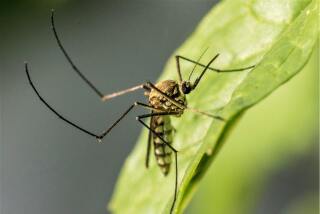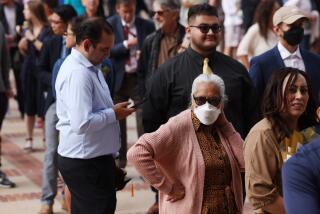AIDS in LOS ANGELES COUNTY
- Share via
Today in Los Angeles County, one of every 200 people is infected with HIV, the virus that causes acquired immune deficiency syndrome. One of every 2,000 people in the county has AIDS, according to county Department of Health Services.
Countywide, 15,616 cases of AIDS have been reported since 1981, with recent dramatic increases among Latinos and women. The overall mortality rate is 72%, accounting for 11,252 deaths as of June 30, 1992.
But, thanks to greater public awareness and “safe sex” practices, there has been a decline in the rate of infection among some groups. Drugs such as AZT (Zidovudine) are helping patients to live longer, and although the need for services to patients remains great, the county’s network of resources and AIDS researchers continues to expand.
Life Cycle of the AIDS VIRUS The AIDS virus replicates by infecting a T-cell, a type of blood cell. Here is how it occurs. 1. Infection begins when the virus binds to the outside of a healthy T-cell and injects its genetic material into the cell. 2. Once inside the cell, genetic material is converted. In a key sequence, viral RNA is changed to viral DNA. This viral DNA migrates to the nucleus, where it is integrated into the T-cells genetic code. The T-cell is now infected and no longer can do its job in the body’s immune system. 3. The infected genetic material now serves as a template for the formation of more viral RNA. When produced, this material migrates to the T-cell membrane, and forms a “bud” that is released from the cell. 4. The enzyme proteinase completes the formation of the new infections HIV virus, which then is free to infect other T-cells in the above manner. SOURCES: Anatomy & Physiology and Hoffmann-La Rouche, Los Angeles County AIDS Epidemiology Program, Centers for Diease Control, AIDS Project Los Angeles, Fred. J. Hellinger of the National Center for Health Services Research and Health Care Technology Assessment NUMBER OF CUMULATIVE AIDS CASES Though June, 1992: Los Angeles County: 15,616 California: 43,699 United States: 218,301* * Through April, 1992 THOSE HIT HARDEST The greatest number of cases reported in the county during 1991 involved people between the ages of 30 and 49.
AGE NUMBER % Under 13 128 1 13-19 35 0 20-29 2,687 17 30-39 6,921 44 40-49 3,879 25 50-59 1,452 9 Over 60 514 3 Total 15,616 100%
Most infected group Age group: 30-39: 44% WHO IS AFFECTED In 1991, the vast majority of reported AIDS cases nationwide involved homosexual or bisexual men. This mirrors the pattern reported in the county since 1981. Here are the cumulative figures.
How Contracted Number % Homosexual/bisexual 12,273 79% male contact Homosexual/bisexual 1,081 7% intravenous drug user Intravenous drug use 771 5% Heterosexual contact 289 2% Transfusion recipient 268 2% Hemophilia or 75 0% coagulation disorder Undetermined 734 4% Total 15,110 100%
Homosexual / bisexual male contact: 79% COUNTY COMPARISON The county’s cumulative AIDS case rate is 195 per 100,000 population, placing it above both the statewide and national figures. The West Hollywood area has the highest AIDS rate in the county.
AREA NUMBER RATE West Hollywood 4,175 903 San Francisco City/County 11,912 * 738 New York City 38,326 * 447 Los Angeles County 15,616 195 California 43,699 141 United States 218,301* 84
* Through April, 1992 AIDS BY AREA
Los Angeles County compiles AIDS statistics by health district. Most of these districts include adjacent cities and unincorporated areas. Listed are the major cities or regional names associated with the districts, the number of AIDS cases, the percentage of the overall county total and the rates per 100,000 population.
%of Rate per Area /District Cases total 100,000 West Hollywood 4,175 27 926 Central Los Angeles 1,505 10 507 Long Beach 1,315 8 342 East Valley 920 6 284 Southwest Los Angeles 621 4 197 Glendale 644 4 188 West Los Angeles 969 6 185 Northeast Los Angeles 460 3 185 Southeast Los Angeles 183 1 151 South Los Angeles 180 1 135 Pasadena 158 1 126 West Valley 737 5 114 Inglewood 431 3 101 East Los Angeles 186 1 97 Compton 232 1 85 Alhambra 231 1 72 Torrance 215 1 65 San Fernando 242 2 64 Pomona 253 2 61 Foothill 167 1 63 Harbor 110 1 62 Whittier 150 1 55 Bell 185 1 53 El Monte 191 1 50 Bellflower 157 1 49 Unknown 999 6 NA TOTAL 15,616 100%
THE DEATH TOLL The county’s number of reported AIDS cases, as well as the number of deaths, increased precipitously during the 1980s. However, in recent years, these rates have leveled off because of safer sex practices, especially among gay Anglo men, and to a lesser extent because of anti-viral drugs such as AZT that have delayed the onset of fully developed AIDS.
Year Cases Deaths 1978 1 0 1979 0 0 1980 3 2 1981 18 17 1982 79 72 1983 268 254 1984 489 455 1985 945 888 1986 1,490 1,400 1987 1,990 1,796 1988 2,245 1,872 1989 2,480 1,834 1990 2,614 1,565*
* Because of delays in reporting new aids cases, many statistics, especially those for recent years, do not accurately reflect the total number of AIDS cases for those time periods. ** Through June 30, 1992 MINORITY CONCERNS The rate at which blacks and Anglos are being infected by AIDS is disproportionately high for to their overall populations in the county.
In the county’s Latino population, there has been an alarming increase in the percentage of new AIDS cases. But compared with their overall population, the percentage of Latinos infected with AIDS remains low.
Here are the reported AIDS cases in the county, as a percentage by ethnicity and year of diagnosis:
Most infected group THE COUNTY The county’s total population by ethnic group: Asian / Pacific: 10% Black: 11% Anglo: 41% Latino: 38% Before 1988 Other: 1% Asian / Pacific: 1% Black: 14% Latino: 15% Anglo: 69% 1988 Other: 1% Asian / Pacific: 1% Black: 18% Latino: 20% Anglo: 60% 1989 Other: 1% Asian / Pacific: 2% Black: 16% Latino: 22% Anglo: 59% 1990 Other: 1% Asian / Pacific: 2% Black: 18% Latino: 23% Anglo: 56% 1991 Other: 1% Asian / Pacific: 2% Black: 17% Latino: 26% Anglo: 54% 1992* Other: 2% Asian / Pacific: 1% Black: 18% Latino: 34% Anglo: 45% *Through June 30, 1992 AIDS AMONG WOMEN Only 4% of those with AIDS in the county are women. However, the rate of infection among women in the county has been rising. Overall, women countywide are stricken at a rate of 6.9 per 100,000. Here is the breakdown for adult and adolescent women since 1981.
How Contracted Number % Heterosexual contact 182 33% Intravenous drug use 159 29% Transfusion recipient 109 20% Hemophilia or coagulation disorder 6 1% Undetermined 96 17% Total 552 100%
From hetersexual contact: 33% CHILDREN WITH AIDS Children account for only about 1% of the AIDS population. The majority of the 128 children in the county who have contracted AIDS received it from their mothers while in the womb or during birth. Most of the others received it from contaminated blood products. Here is a breakdown:
How Contracted Number % Mother with or at risk of AIDS 71 55% Blood Transfusion recipient 47 37% Hemophilia or coagulation disorder 7 5% Undetermined 3 2% Total 128 1005
From mother with or at risk of AIDS: 55% WHAT IS HIV?:
The human immunodeficiency virus, which destroys the immune system, leaves the body vulnerable to infections, tumors and probable death. MEANS OF INFECTION:
The virus can be transmitted by infected blood, sexual intercourse with an infected partner, sharing of intravenous drug equipment with an infected person, or from an infected woman to her child prior to birth or through her breast milk. PREVENTING INFECTION:
* Abstain from sex * Have intercourse with only one partner * Use latex condoms * Do not have sex with intravenous drug users * Do not share needles AIDS RESOURCES Information and Referral Lines Southern California AIDS Hot Line (800) 922-2437 or 922-AIDS (213) 876-2437 or 876-AIDS Mon.-Fri. 9 a.m.- 9 p.m. Sat. & Sun. 9 a.m. - 6 p.m. Southern California Spanish-Language AIDS Hot Line (800) 222-7432 or 222-SIDA (24 hours) Multilingual AIDS Referral Line (800) 922-2438 (24 hours) Hearing-Impaired AIDS Hot Line (TDD) (800) 553-2437 or 553-2437 Mon.-Fri. 9 a.m.- 9 p.m. Sat. & Sun. 9 a.m. - 6 p.m. Compiled by Times researcher MICHAEL MEYERS






